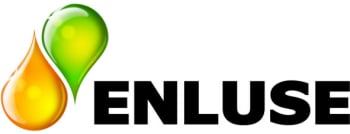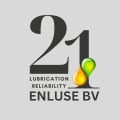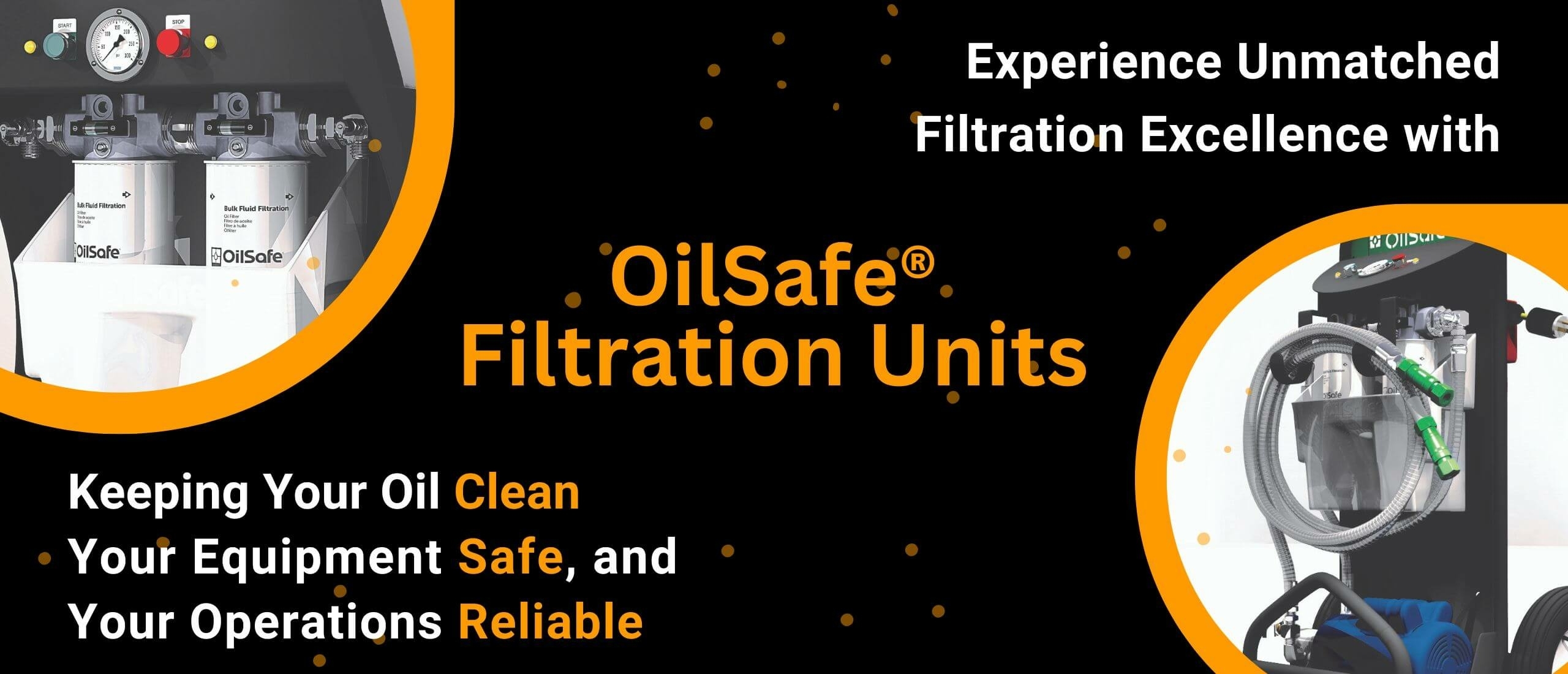
OilSafe Filtration Units
Fluid cleanliness in preventing machine failures
This blog describes the importance of fluid cleanliness in preventing machine failures caused by contamination. Various types of contaminants, such as solids, dirt, wear metals, water, and air, can enter the system and transport them to bearings, gears, and other components.
Introduction to the OilSafe Filtration Units
The OilSafe filtration units, both portable and stationary, are designed to address these concerns. They prioritize safety with spill protection measures, including quick disconnects, removable spill bases, and spill containment troughs.
The filtration units utilize Beta 2000 filters with different micron sizes to efficiently remove solids and even water from the fluid. The ease of use is emphasized, with colour-coded connections and easily replaceable filter elements.
Safety features, such as slower oil flow to minimize static and bonded media to prevent bypassing, are incorporated. The systems also facilitate oil analysis and monitoring with before and after sampling ports and differential pressure gauges.
Stationary units are suitable for circulating systems, hydraulic systems, gearboxes, and lube rooms, while portable units are ideal for dedicated lubricants in various applications. They are robust and AC-driven for heavy-duty use.
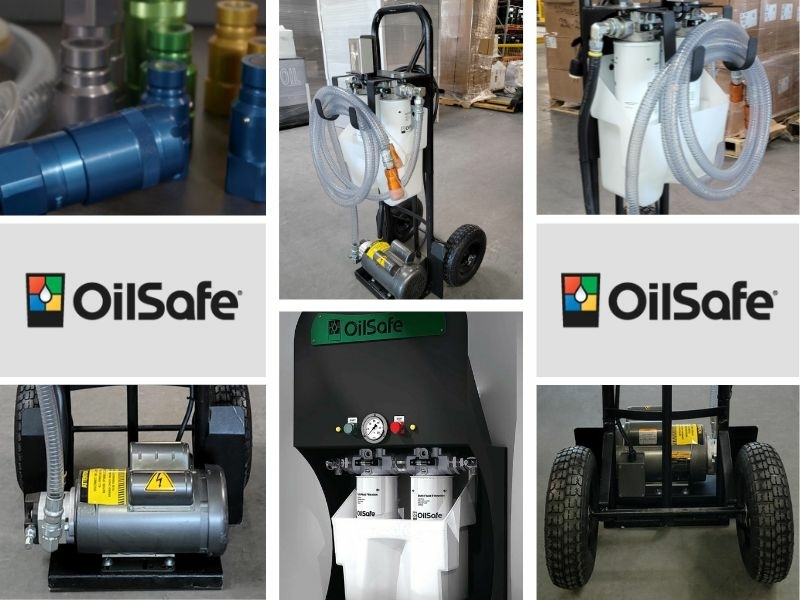
Portable Filtration Units
Portable OilSafe filtration units are compact and mobile systems that provide on-site filtration capabilities. They are designed for ease of transportation and are typically equipped with wheels or handles for convenient mobility. These units offer flexibility and can be easily moved to different job sites or work areas where oil filtration is required. They are commonly used for maintenance tasks, small-scale operations, or situations where a permanent filtration setup is not feasible. Despite their smaller size, portable units often feature high-quality filtration elements, pumps, hoses, and controls to deliver effective filtration performance.
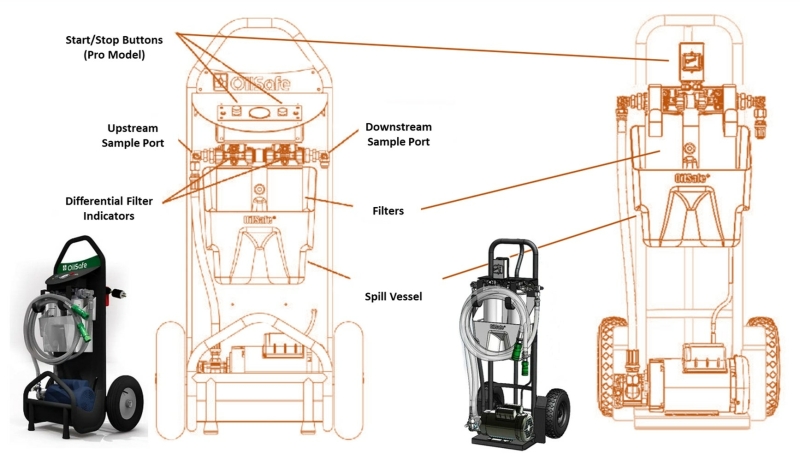 Portable Filtration Units
Portable Filtration Units
| P/N | Description |
| 957780-PRO | OilSafe Portable Filtration Cart - Pro |
| 957750-NF1 | OilSafe Portable Filtration Cart - Basic - One Filter |
| 957750-NF2 | OilSafe Portable Filtration Cart - Basic - Two Filters |
Stationary Filtration Units
Stationary OilSafe filtration units are lfixed systems designed for continuous or dedicated oil filtration applications. These units are typically installed in a fixed location within an industrial facility or lubrication room. They are suitable for applications that require a constant supply of clean oil or for larger-scale operations where filtration needs are more substantial. Stationary units may include advanced features and options, such as multiple filter housings, automated controls, oil monitoring systems, and integration with existing machinery or equipment. They are built to handle higher flow rates and can accommodate larger oil volumes.
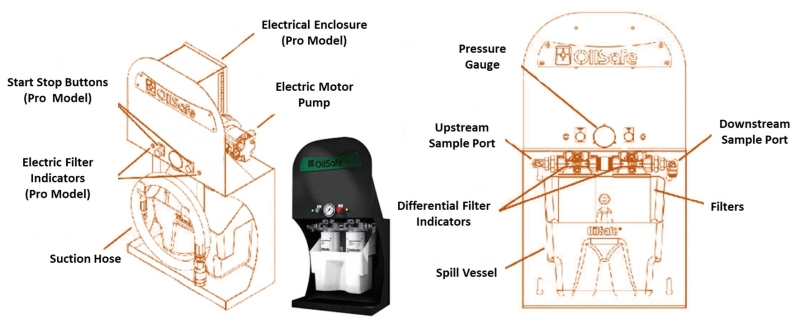 Stationary Filter Unit
Stationary Filter Unit
| P/N | Description |
| 957700-PRO | OilSafe Wall Mount Stationary Filtration Panel - Pro |
| 957700-BASIC | OilSafe Wall Mount Stationary Filtration Panel - Basic |
Features and Benefits
Both portable and stationary OilSafe filtration units share common features and benefits, including:
Filtration Efficiency:
These units utilize high-quality filtration elements, such as micro glass anti-static filters, to effectively remove contaminants, dirt, water, and particulate matter from the oil. This helps maintain the cleanliness and integrity of the oil, enhancing equipment performance and longevity.
Contamination Control:
The filtration units help control and reduce contamination in oil systems, preventing premature wear, component damage, and equipment failures. Clean oil contributes to smoother operations, improved productivity, and reduced maintenance costs.
Customization Options:
OilSafe filtration units can often be customized based on specific requirements. Additional features, such as flow meters, pressure gauges, oil sampling ports, and various filter configurations, can be incorporated to suit specific application needs.
Ease of Use:
Both portable and stationary units are designed to be user-friendly, with intuitive controls and indicators for monitoring filtration progress and system status. This allows operators to easily operate and maintain the filtration units.
Cost Savings:
By extending the life of lubricating oils and fluids, OilSafe filtration units help reduce the frequency of oil replacements and disposal costs. They contribute to improved equipment reliability, reduced downtime, and overall cost savings in terms of maintenance and oil consumption.
Clean. Protect. Extend.
OilSafe Filters: Keeping Your Equipment Running Smoothly and Safely
Stationary and portable filtration units are essential for maintaining clean and high-performance oil systems in industrial applications. These units consist of key components such as filter housings, filter elements, pumps, controls, and monitoring systems. Whether stationary or portable, these components work together to effectively remove contaminants from lubricating oils and fluids, extending the life of equipment and ensuring smooth operations.
Modes of Operation
OilSafe filter units operate in different modes to effectively remove contaminants from lubricating oils and fluids. Here are the common modes of operation:
Portable Filtration Unit: Off-Line Filtration
In this mode, the unit actively filters the oil or fluid, removing particles, dirt, and other contaminants. The oil passes through the filter elements, which trap and retain the contaminants, ensuring cleaner oil circulation.
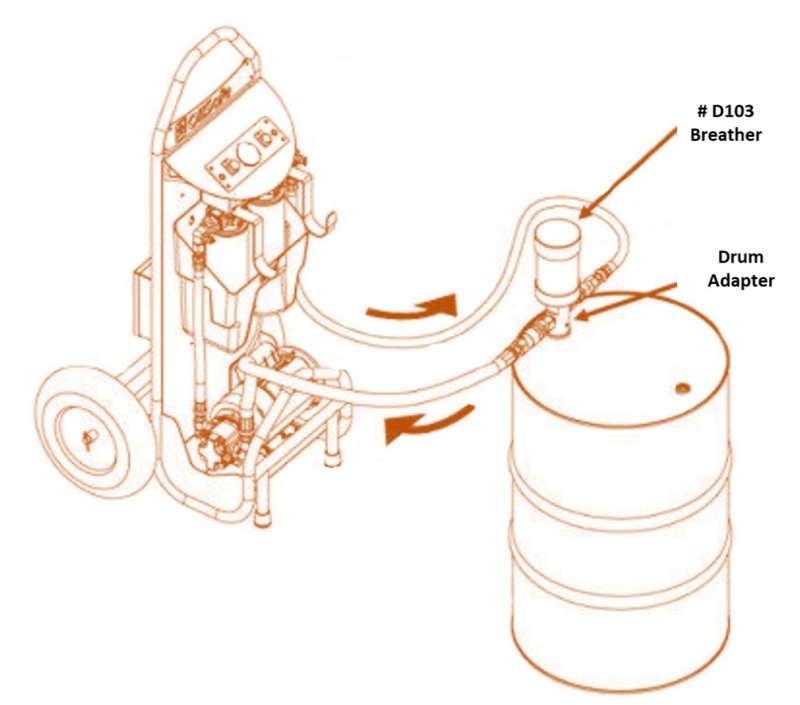 Off-Line Filtration (Portable Filtration Unit)
Off-Line Filtration (Portable Filtration Unit)
Portable Filtration Unit: Fluid Transfer Mode
When transferring oil from a drum or container into equipment using a portable filtration unit, there are a few steps you can follow to ensure a smooth and efficient process. Here's a general guide:
- Prepare the equipment: Ensure that the equipment you're transferring oil into is clean and ready to receive the oil. This may involve cleaning out any residue or contaminants from the equipment.
- Set up the portable filtration unit: Place the portable filtration unit near the drum or container containing the oil. Make sure it is stable and properly connected to any required power sources.
- Choose the appropriate filtration media: Select the filtration media suitable for the type of oil you're transferring. This may involve using filters designed specifically for oil filtration to remove impurities, contaminants, and debris.
- Connect the input and output hoses: Attach the input hose from the filtration unit to the drum or container holding the oil. Ensure a secure connection to prevent leaks. Connect the output hose from the filtration unit to the equipment where the oil will be transferred.
- Start the filtration unit: Turn on the filtration unit, following the manufacturer's instructions. The unit will begin pumping oil from the drum or container, through the filtration media, and into the equipment.
- Monitor the filtration process: Keep an eye on the filtration unit to ensure it is functioning correctly. Check for any leaks, and make any necessary adjustments or repairs if needed.
- Complete the transfer: Once the oil has been transferred from the drum or container and filtered, you can shut off the filtration unit and disconnect the hoses. Ensure that the equipment receiving the oil is properly filled.
- Clean and maintain the filtration unit: After completing the transfer, clean the filtration unit and remove any used filters or filtration media. Follow the manufacturer's instructions for maintenance and storage of the unit.
 Fluid Transfer: Oil is transferred from drum (or container) into equipment
Fluid Transfer: Oil is transferred from drum (or container) into equipment
Portable Filtration Unit: Dedicated Off-Line Filtration
When using a portable filtration unit in off-line mode for kidney-loop filtration, the process involves recirculating oil within the equipment to continuously remove impurities and maintain oil quality.
 Kidney-loop filtration
Kidney-loop filtration
Stationary Filtration Unit: Off-Line Filtration
Stationary off-line filtration is a filtration method where the oil or fluid is circulated within a stationary drum, tote, or container. The process involves connecting the filtration unit to the container and pumping the oil or fluid through the filtration system.
The oil is continuously recirculated within the closed system, passing through the filter elements to remove contaminants and maintain cleanliness.
This method is commonly used for batch filtration or when a dedicated supply of filtered oil is required for specific applications. It allows for efficient filtration without the need for continuous flow-through systems, making it suitable for situations where oil is stored in drums or totes.
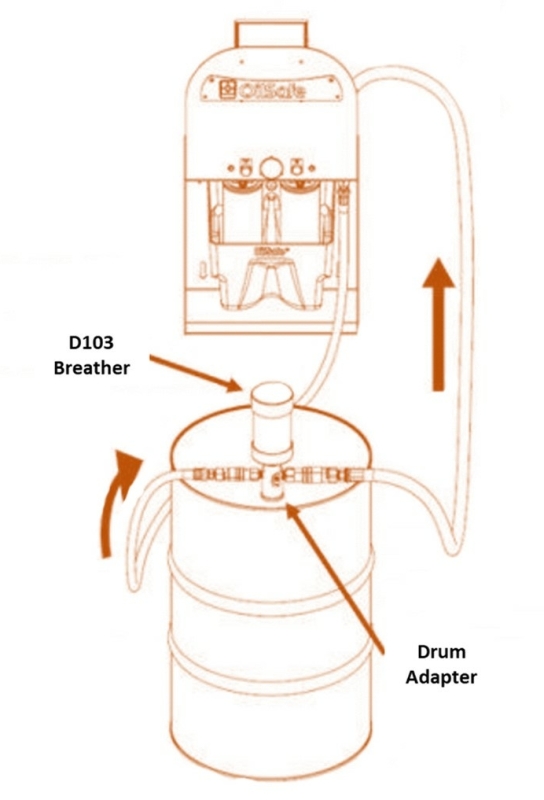 Stationary Off-Line Filtration
Stationary Off-Line Filtration
Stationary Filtration Unit: Fluid Transfer
Fluid transfer is a mode of operation in which oil or fluid is pumped from a storage container or drum into the equipment or system that requires lubrication or fluid replenishment.
This process involves connecting the OilSafe filtration unit to the container and using the unit's pump to transfer the oil or fluid into the equipment. The filtration unit ensures that the transferred fluid is clean and free from contaminants, promoting the smooth operation and longevity of the equipment.
Fluid transfer is a common mode of operation for maintenance tasks such as refilling oil reservoirs, topping up fluids, or transferring lubricants between different equipment or systems.
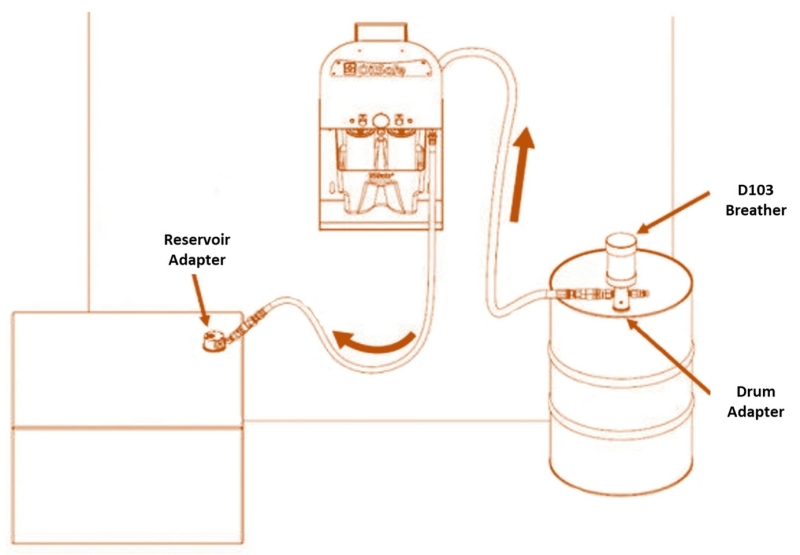 Fluid Transfer
Fluid Transfer
Stationary Filtration Unit: Dedicated Off-Line Filtration
Dedicated off-line filtration refers to a filtration setup where a dedicated filtration unit is permanently connected to a specific piece of equipment or system for continuous or periodic filtration. In this configuration, the filtration unit operates independently of the equipment's primary hydraulic or lubrication system. The oil or fluid is diverted from the equipment's reservoir and circulated through the dedicated filtration unit.
This setup allows for ongoing filtration to maintain optimal fluid cleanliness, removing contaminants and ensuring the smooth operation and longevity of the equipment.
Dedicated off-line filtration is particularly useful for critical equipment that requires constant purification of the fluid, such as large industrial machinery, power generators, or hydraulic systems with stringent cleanliness requirements.
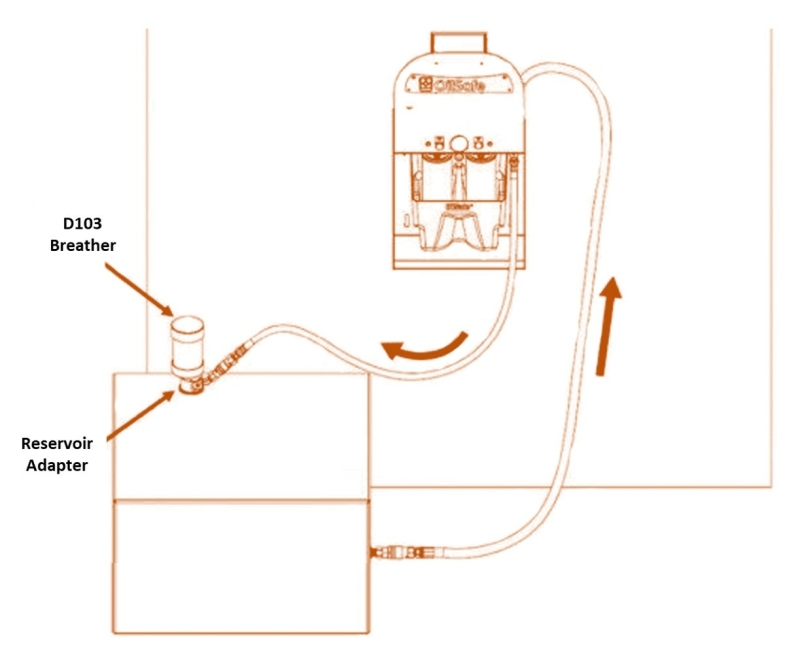 Dedicated Off-Line Filtration
Dedicated Off-Line Filtration
Servicing Filter Elements
OilSafe Filtration Systems are designed with removable spill containment vessels, which greatly facilitate the servicing of filter elements. These spill containment vessels provide a convenient and secure location for the filter elements during maintenance, preventing spills and leaks that can lead to safety hazards and messy cleanup.
By containing any potential spills within the removable vessel, the process of servicing filter elements becomes safer and cleaner, minimizing the risk of environmental contamination and reducing the chances of slips, trips, or falls due to oil spills.
This feature enhances the overall usability and user-friendliness of OilSafe Filtration Systems, ensuring efficient and hassle-free filter element servicing.
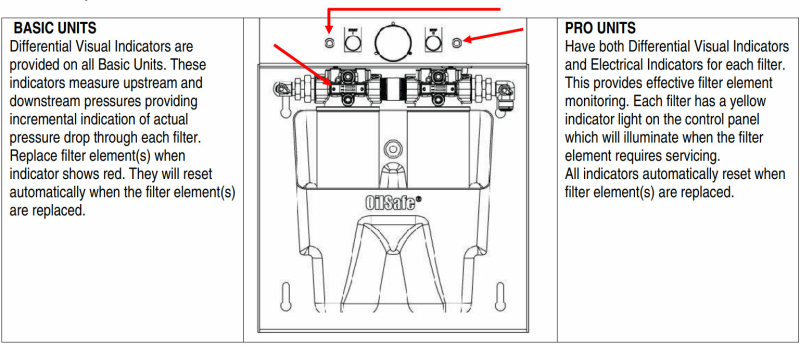
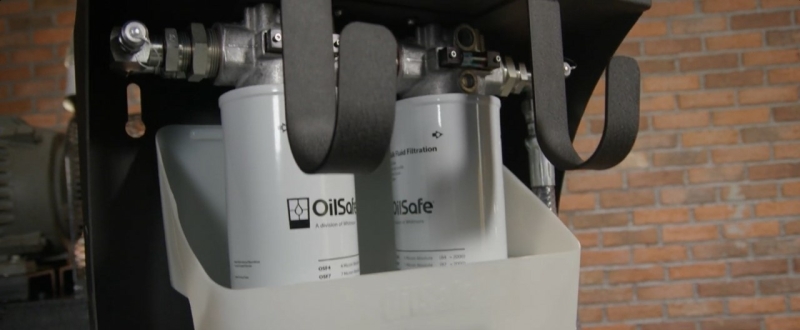
Quick Disconnects
OilSafe Filtration Units are equipped with specific sizes of female quick disconnects to ensure proper connections and minimize the risk of spills or leaks. Here is a list of the corresponding mating (male half) quick disconnects for installing onto equipment:

½” Male Quick Disconnects:
These are compatible with the ½” female quick disconnects on the discharge/outlet hoses of OilSafe Filtration Units. The colourized flat-faced quick disconnects provide error-free connections, and the corresponding colours are:
- Red (Mating Half)
- Blue (Mating Half)
- Green (Mating Half)
And so on, depending on the colour coding system used.
¾” Male Quick Disconnects:
These are compatible with the ¾” female quick disconnects on the suction hoses of OilSafe Filtration Units. The colourized flat-faced quick disconnects ensure spill-free access and prevent connections to dissimilar colours. The corresponding colors are the same as mentioned above.
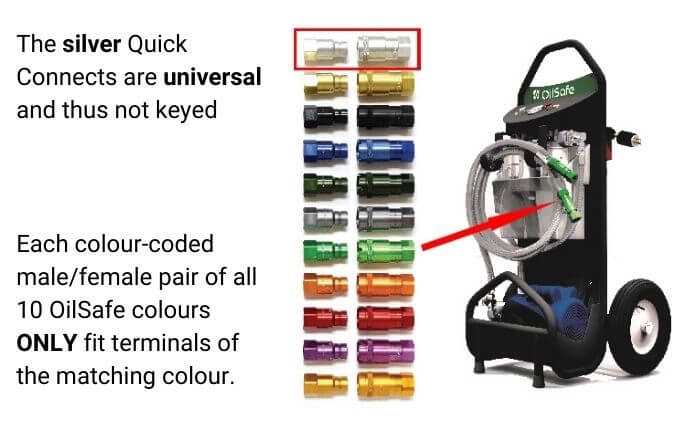 Portable Filter Unit and colour-code quick connects
Portable Filter Unit and colour-code quick connects
By using the colour-coded quick disconnects, users can easily and accurately connect the filtration unit to equipment without the risk of mismatched connections. This helps to prevent leaks, spills, and cross-contamination during the connection and disconnection process.
ISO B quick disconnects
ISO B quick disconnects can indeed serve as an alternative to the zero-leak, error-proofing quick disconnects mentioned earlier. While ISO B quick disconnects may have a higher likelihood of oil leakage during the mating and disconnecting process, they offer an economical option for connecting equipment to OilSafe Filtration Units.
ISO B quick disconnects are widely used in various industries and offer a reliable and relatively cost-effective solution for fluid connections. However, it's important to note that the increased potential for leakage during connection and disconnection means that extra care and attention should be taken to prevent spills or contamination. Proper training and handling procedures should be followed to minimize the risk of leaks and maintain a clean and safe working environment.
Ultimately, the choice between zero-leak, error-proofing quick disconnects and ISO B quick disconnects depends on the specific requirements, budget considerations, and desired level of leakage prevention for the given application.

Removing Filter Elements
When removing filter elements from a Filtration Unit, it is crucial to follow proper safety protocols. Here are the steps to safely remove filter elements:
- Ensure System Safety: Before starting the filter element removal process, make sure the system is shut off, unplugged, and deemed safe for servicing. This ensures that there is no risk of electrical shock or unexpected activation of the system during the procedure.
- Loosen Filter Elements: Turn the filter elements counterclockwise to loosen them from the threads on the filter heads. Apply gentle pressure while turning to prevent damage to the threads or the filter elements themselves. As the filter elements detach, allow them to rest in the OilSafe containment vessel.
- Contain Residual Oil: As the filter elements are removed, residual oil may be encapsulated within them. By letting the filter elements rest in the OilSafe containment vessel, any residual oil is contained, preventing spills or leaks. This promotes a safer and cleaner environment during the servicing process.
- Dispose of Used Filter Elements: Once the filter elements are safely contained in the OilSafe vessel, they can be conveyed to the designated used oil collection area. Follow proper disposal procedures for used filter elements and comply with any local regulations or guidelines for their disposal.
By adhering to these steps, you can ensure the safe and efficient removal of filter elements from Filtration Units, minimizing the risk of spills, maintaining a clean working environment, and facilitating proper disposal of used filter elements.
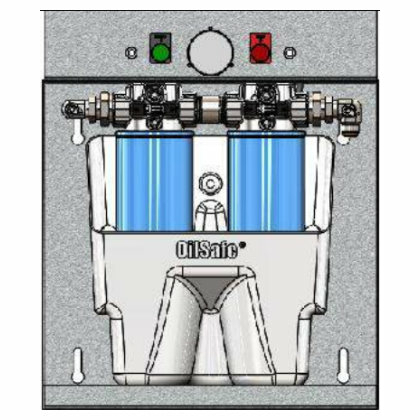 Removing Filter Elements
Removing Filter Elements
Replacing Filter Elements
When replacing filter elements in a Filtration Unit, follow these steps for a proper and effective installation:
- Prepare New Filter Elements: Dispose of the used filter elements according to proper disposal procedures. Take the new filter element(s) and place them in the spill containment vessel provided by OilSafe.
- Hang the Spill Containment Vessel: Attach the spill containment vessel, with the new filter element(s) inside, onto the filtration system. Ensure it is securely hung in place and properly aligned with the filter head.
- Lubricate O-Rings: Check for the presence of two O-rings already installed on the filter element(s). Apply a thin layer of lubricant or oil to the O-rings to facilitate a proper seal and ease the installation process.
- Reinstall the Filter(s): Take the lubricated filter element(s) and carefully reinstall them onto the threads of the filter head. Rotate the filter element(s) clockwise, ensuring it is aligned properly with the threads. Continue rotating until the filter element(s) bottom out and stop turning. This indicates that the filter element(s) are securely in place.
By following these steps, you can successfully replace the filter elements in your Filtration Unit. Proper installation ensures a tight seal, effective filtration, and reliable performance of the filtration system.
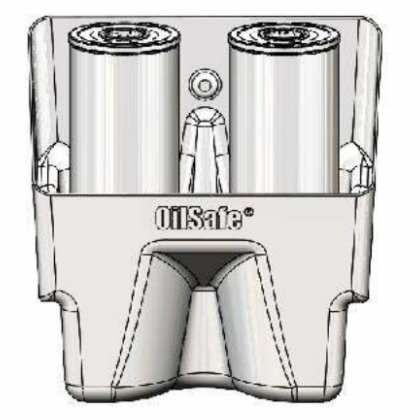 Replacing Filter Elements
Replacing Filter Elements
Maintenance Checklist
Here is a maintenance checklist for regular use and every six months:
EVERY USE:
- Perform a visual inspection of the filtration system to ensure operational integrity and safety.
- Check Filter Indicators: The filter head should have a differential pressure indicator that shows when a filter is plugged and needs changing.
- If there are any oil drips or spills, stop and clean them immediately to prevent accidents and maintain cleanliness.
EVERY 6 MONTHS:
- Replace Filter Elements: Replace the filter elements according to the manufacturer's recommendations or based on the condition of the filters.
- Check Pneumatic Tire Pressure on Portable Filtration Carts: Ensure that the tire pressure on any portable filtration carts is at the recommended level.
- Inspect Hoses: Check hoses for cracks, abrasions, kinks, or leaks. Repair or replace any damaged hoses as necessary.
- Check Mounting Hardware: Inspect all mounting hardware, including fasteners and connectors, to ensure they are tight and secure.
- Clean Surfaces: Regularly clean surfaces to keep them safe and free from excess oil films. This helps maintain cleanliness and prevents any potential hazards.
Remember to consult the equipment manufacturer's instructions and guidelines for specific maintenance procedures and intervals.
Guidelines
These guidelines are important to ensure the safe and effective use of the equipment. Here's a summary of the key points:
- Compatibility with lubricating oils: The OilSafe® Filtration Units are designed specifically for use with non-aggressive lubricating oils. It is important to ensure that the oils used are compatible with the unit to avoid any damage or malfunction.
- Flashpoint requirements: The unit should not be used with fluids that have flashpoints below 150°F (or 65.5°C). Flashpoint refers to the temperature at which a fluid can ignite when exposed to an open flame or heat source. This requirement helps ensure safety during the filtration process.
- Electrically powered systems: If the filtration unit is electrically powered, it should not exceed a maximum pressure of 150 psi (or 10.34 bar). Additionally, electrically powered systems are limited to handling lubricating oils with viscosities ranging from ISO 10 to 680. Viscosity is a measure of a fluid's resistance to flow and is usually specified using the ISO viscosity grade system.
- Pneumatic powered systems: If the filtration unit is pneumatically powered, it should not exceed a maximum pressure of 120 psi (or 8.27 bar). Pneumatic systems are also limited to handling lubricating oils with viscosities up to ISO 680.

It's crucial to strictly adhere to these limitations and specifications to prevent damage to the equipment, ensure operator safety, and maintain optimal filtration performance. Always refer to the manufacturer's documentation and guidelines for detailed instructions on the safe and proper use of the OilSafe® Filtration Units.
A detailed manual that covers additional maintenance procedures and information has been prepared. To download the manual, simply click the button below:
If you have any further questions or need assistance, please feel free to reach out to our support team.
